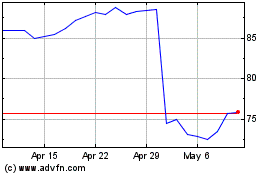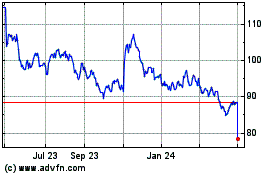By Micah Maidenberg
The cocoa that Mondelez International Inc. used to make the last
Oreo you ate might have come from a farm about the size of a
football field about 5 miles southwest of a wildlife sanctuary in
Ghana.
It is possible to know this because Mondelez publishes online
relatively granular data about its cocoa supply chain. On a company
website, a map with satellite views pinpoints the locations of more
than 93,000 farms in Ghana, Ivory Coast and Indonesia that it
tapped last year, through suppliers, to get some of the raw
material it needs to make chocolate products.
"What the consumer really wants to understand is that we have
provenance of our supply," says Jonathan Horrell, global director
of sustainability at Mondelez.
Big food companies, from Mondelez and General Mills Inc. to
Unilever PLC and Nestlé SA, face rising pressure to address
problems across agricultural regions as shoppers pay more attention
to where their food comes from and how it is produced. As huge
buyers of ingredients like cocoa, palm oil and coffee, food
companies must do more, for example, to stop deforestation carried
out by suppliers and encourage farmers to stop using child labor,
regulators, advocacy groups and consumers say.
Companies are responding in part by serving up new information
online about the commodities they buy around the world. The data,
once the domain of purchasing specialists and transportation
planners, is starting to give investors and the public a glimpse
into the sprawling supply chains the companies have spent years
developing.
For advocacy groups, the information is welcome, even if they
lament that it took this long and that it isn't enough.
"It's a first step that should have been taken a long time ago,"
says Diana Ruiz, senior campaigner focused on palm oil at
Greenpeace USA.
The most information being made available covers palm oil, an
ingredient companies use in everything from frozen pizza to soap.
For years, environmental organizations have implicated palm oil in
the clearing of tropical forests and demanded buyers do more to
halt that. Now, they are using company disclosures in their
campaigns. Rainforest Action Network used palm-oil-mill lists
published by major U.S. and European consumer-product companies in
a September report that said those firms may be using palm oil
produced in an ecologically sensitive wildlife preserve in
Indonesia. Slash-and-burn farming practices are a major problem in
the country.
Mondelez, General Mills and Kellogg Co. are among the food
manufacturers now posting lists online of companies that mill the
palm oil they buy from traders. Unilever discloses on its website
the location of its palm-oil mills and refineries. Nestlé makes
available online lists of slaughterhouses it has tapped to get
beef, pork and lamb, palm-oil mills and other suppliers.
"We wanted to stop this kind of negative perception of the food
industry, Nestlé, everybody, that this is a black box that nobody
understands, " says Benjamin Ware, global head of responsible
sourcing at Nestlé.
By their nature, commodities are undifferentiated products that
are meant to be easily aggregated, traded and shipped. For decades,
finding detailed information about supply chains was challenging.
Sourcing and transactions were often considered trade secrets, and
problems were largely kept out of public view.
That it is now possible to know where food makers bought some of
their ingredients represents a degree of progress, environmental
and human-rights groups say, allowing them to more easily look into
commercial relationships and whether suppliers are meeting company
goals and industry standards. Computing power, including satellite
mapping, has made it easier to collate information and track
conditions in farming areas.
"We're living in an age of data and information in every aspect
of our lives," says Luiz Amaral, a director focused on commodities
and finance for the World Resources Institute, a Washington,
D.C.-based research organization focused on the environment. "It
isn't going to be any different in commodity supply chains," Mr.
Amaral says.
The shift toward more disclosure in supply chains has its roots
in the 1990s, when consumers in wealthier countries started to
become more aware of labor conditions in developing-world factories
producing shoes and apparel.
Legislators have since pressed to boost laws governing supply
chains. The U.K., California and other places have passed laws
requiring companies to disclose information about what they are
doing to eradicate slavery from supply chains. Sens. Sherrod Brown
(D., Ohio) and Ron Wyden (D., Ore.) in July called on Department of
Homeland Security officials to use an existing law to stop
companies from importing cocoa produced with forced child
labor.
At the same time, more consumers say they care about where their
food comes from and how it is made, a trend connected to heightened
expectations from shoppers about the healthfulness and
environmental impact of what they eat. The ubiquity of digital
devices and spread of social media, meanwhile, allows consumers to
quickly learn more about conditions in agricultural regions, such
as earlier this year when forest fires in the Amazon region of
Brazil drew global attention.
"When empowered individuals have the ability to search and learn
more information, we were forced to up our game and to understand
the complexity and intricacies of supply chain in a way we hadn't
before," says John Church, chief supply-chain officer at General
Mills.
About 60% of shoppers in the U.S., China and three major
European markets said they place a strong emphasis on the source of
ingredients when purchasing healthier products, according to a
survey conducted last year by the consulting firm AlixPartners.
Starbucks Corp., which buys coffee from more than 400,000 mostly
small farmers who sell to nearby mills, plans to offer information
about the country of origin for its bagged coffees via its mobile
app. It's still deciding how detailed to make that information.
Both coffee farmers and consumers are interested in knowing more
about how coffee makes it from farm to store, says Kelly Goodejohn,
director of ethical sourcing and traceability at the company.
Farmers could potentially use that information for commercial
purposes, according to Starbucks.
Still, more disclosure doesn't necessarily mean deeper insight
into business practices. For most shoppers, sorting through
suppliers of agricultural commodities offers little in the way of
context or ideas for taking any action.
"It's extraordinarily difficult to know, if you're not in the
industry, which processes are more likely to produce good results,"
says Adam Chilton, a University of Chicago law professor who has
written about supply-chain transparency. And while consumers say
they want information about ingredients, only 14% selected
supply-chain transparency as an important factor when looking at
food-product labels, according to a survey that consumer-research
firm Euromonitor conducted earlier this year of shoppers in major
countries around the world.
Publishing lists of suppliers doesn't necessarily change
conditions on the ground either.
Social and environmental advocates say companies must do more
than release data about suppliers. Such groups want makers of
well-known consumer products to use their economic clout as
purchasers of vast quantities of agricultural products to force
change by cutting off farmers and producers who break commitments
on issues like deforestation and human rights.
"We can tell them they shouldn't be buying from supplier X,
because they're in violation," says Marcus Colchester, senior
policy adviser at British group Forest Peoples Program, which works
with indigenous people. "And we can hope they'll tell supplier X,
unless they quickly change, they'll stop buying from them. It's
that last part that's not so clear yet."
Mr. Maidenberg is a reporter for The Wall Street Journal in New
York. He can be reached at micah.maidenberg@wsj.com.
(END) Dow Jones Newswires
October 09, 2019 19:17 ET (23:17 GMT)
Copyright (c) 2019 Dow Jones & Company, Inc.
Starbucks (NASDAQ:SBUX)
Historical Stock Chart
From Mar 2024 to Apr 2024

Starbucks (NASDAQ:SBUX)
Historical Stock Chart
From Apr 2023 to Apr 2024
